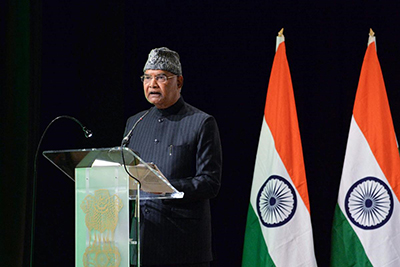Relevance: GS-2: Parliament and State legislatures—structure, functioning, conduct of business, powers & privileges and issues arising out of these.
Key Phrases: Presidential election, National Capital Territory, Election Commission, proposers, seconders, nomination, Union Territories, electoral college, Head of State.
Why in News?
- The tenure of the current President of India is set to end in July this year, which is also when the 16th Indian Presidential election will be held to elect his successor.
How is the President elected?
- The Indian President is elected through an electoral college system, wherein the votes are cast by national and State-level lawmakers.
- The elections are conducted and overseen by the Election Commission (EC) of India.
- The electoral college is made up of all the elected members of the Upper and Lower Houses of Parliament (Rajya Sabha and Lok Sabha MPs), and the elected members of the Legislative Assemblies of States and Union Territories (MLAs).
- This means, in the upcoming polls, the number of electors will be 4,896 — 543 Lok Sabha MPs, 233 MPs of the Rajya Sabha, and 4,120 MLAs of all States, including the National Capital Territory (NCT) of Delhi and Union Territory of Puducherry.
- Before the voting, comes the nomination stage, where the candidate intending to stand in the election, files the nomination along with a signed list of 50 proposers and 50 seconders.
- These proposers and seconders can be anyone from the total of 4,896 members of the electoral college from the State and national level.
- The rule for securing 50 proposers and seconders was implemented when the EC noticed, in 1974, that several candidates, many without even a bleak chance of winning, would file their nominations to contest the polls.
- An elector cannot propose or second the nomination of more than one candidate.
What is the value of each vote and how is it calculated?
- A vote cast by each MP or MLA is not calculated as one vote. There is a larger vote value attached to it.
- The fixed value of each vote by an MP of the Rajya Sabha and the Lok Sabha is 708. Meanwhile, the vote value of each MLA differs from State to State based on a calculation that factors in its population vis-a-vis the number of members in its legislative Assembly.
- As per the Constitution (Eighty-fourth Amendment) Act 2001, currently, the population of States is taken from the figures of the 1971 Census.
- This will change when the figures of the Census taken after the year 2026 are published.
- The value of each MLA’s vote is determined by dividing the population of the State by the number of MLAs in its legislative Assembly, and the quotient achieved is further divided by 1000.
- Uttar Pradesh for instance, has the highest vote value for each of its MLAs, at 208. The value of one MLA’s vote in Maharashtra is 175, while that in Arunachal Pradesh is just 8.
- The total votes of each Legislative Assembly are calculated by multiplying the vote value of each MLA by the number of MLAs.
- Finally, based on these values, the total number of votes of all Rajya Sabha and Lok Sabha MPs would be 5,59,408 (776 MPs X 708), and the total votes of all MLAs from State Legislative Assemblies would come up to 5,49,495.
- Thus, the grand total vote value of the whole electoral college comes up to 10,98,903.
What is required to secure a victory?
- A nominated candidate does not secure victory based on a simple majority but through a system of bagging a specific quota of votes.
- While counting, the EC totals up all the valid votes cast by the electoral college through paper ballots and to win, the candidate must secure 50% of the total votes cast + 1.
- Unlike general elections, where electors vote for a single party’s candidate, the voters of the electoral college write the names of candidates on the ballot paper in the order of preference.
Do you Know?
- The election of president should be completed before the end of tenure however in case of vacancy in the office the election should be completed within 6 months from the day of vacancy.
- The salary and other allowances are decided by parliament and are charged upon consolidated fund of India.
- Nilam Sanjiv Reddy was elected unopposed he had remained speaker of Lok Sabha Twice before being elected as president.
- Zakir Hussain and F.A Ahmed died in office.
- Only Rajendra Prasad elected twice as president of India.
Conclusion
- The Office of president is far greater and can in no way be combined with the responsibilities of any other high office or function.
- One of the paramount functions of the Office is to influence political thought and institutional direction in the national interest.
- In this regard the President serves as a mediator in times of national crisis and should be instrumental in preparing the nation to co-operate with the government’s policies and programmes.
- This leaves no room for the Head of State to be regarded as a ‘rubber stamp’ because his sphere of influence has far reaching implications. Hence his election becomes very crucial and significant.
Sources: The Hindu
Mains Question:
Q. Briefly discuss process of electing India’s President. How is the vote value for each MP/MLA calculated? (250 Words).









